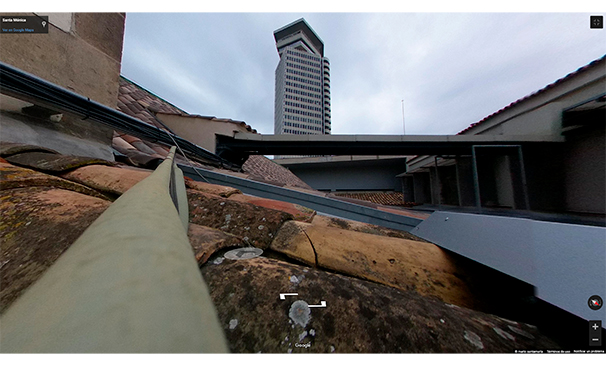What are you looking for?
You might be looking for...
VIRTUAL TOUR

The Santa Mònica in your hands without leaving home. During the virtual tour of the centre, you will not only be able to visit its cloister and exhibition areas but also penetrate its most inaccessible corners, explore unusual perspectives and follow routes that you would never have imagined. Start your tour now, full of previously unshown content and unusual sights that will definitely surprise you.
Sliding between the layers of the screen
By Doreen A. Ríos
Let's think about the idea of the interface. One common interpretation is that it is a go-between: a means to an end. We think of interfaces as if they didn't have a telos (an ultimate goal or desired form) but were only the by-product of an idea and the forerunner of a form. Generally speaking, an interface in the digital age suggests the idea that it exists to connect us, humans, with various machines, in which we enter a feedback process that links our bodies to an expanded space that usually exists inside a screen.
This conception, transplanted to a recent conversation about the digitisation of everything, leads us to a logical framework in which, apparently, this process exists to replicate what we have around us. But then the question arises: Where else can we take these experiences?
It is clear that Mario Santamaría's work has focused on expanding the possible answers to this question by hybridising the experience and, above all, by making obvious the processes – and even giving them material form – that take place behind the digital tools he uses to give shape to his work.
The virtual tour that Santamaría designed for the Santa Mònica is a clear example of what can happen when we explore our tools beyond the production limits attributed to them. This proposal for an architectural voyage not only confronts us with the vulnerability of built space but also with the forms of habitation used by its non-human residents and the memories trapped in the walls, materialised as lost objects. Commenting on the numerous virtual tours produced in recent years, and perhaps with a critical emphasis on those created during 2020, the artist takes as his starting point the notion of the expanded trial, that is, that which does not translate literally into the existing space but which seeks, through his tools of creation, a perspective that goes beyond what we can perceive in situ.
At this point, I would like to broaden this reflection with two questions: What happens with the tools that are objects? And vice-versa, what happens with the artefacts that are not just de facto encapsulations of their production and consumption conditions, at the most basic level, but also critically comment on the conditions of the network and other factors associated with the technologies used in their manufacture? Undoubtedly, this journey proposed by Santamaría transits between both worlds by acknowledging that it is possible to achieve other goals of representation that are not tied to the logic of reproduction but tell us about the flexibility of the soft tools used to create them.
On this point, it seems pertinent to me to consider the adjective soft embedded in the word software. While obviously referring to the softness and malleability of the gestures that can be created with these tools, it also evokes the soft power1 exercised through the dominant aesthetics. My intention with these remarks is to highlight the diversity of perspectives contained in this tour. Although the artist makes intensive use of image capture and magnification tools to create a digital representation of the materials, textures, shapes and colours in the Santa Mònica, there is a specific element of the atmosphere he captures that is not the identical replica but its mutant twin: scale. Clearly, the hegemony in the use of soft tools has a seductive effect on us, replicating time and time again the exercise of soft power that gives preference to the formats that most resemble what is tangible. However, these same soft tools hold the possibility of transforming themselves, reinventing themselves and invoking other types of sensibilities.
This piece is a dispersed echo rooted in disobedient machines, an invitation to go beyond our most primordial interface – the body – to look, and look at ourselves, through unknown planes and a journey that, little by little, reveals the interior of the fissures that we cannot enter.
----------------
1. A term coined by Joseph Nye to refer to ideological imposition exercises based on long-term exercises linked to cultural products that are habitually related to the perpetuation of colonial, misogynist, homophobic or similar exercises.
Enter the visit from the first floor
Enter the visit from the Rambla
Doreen A. Ríos (Toluca, Mexico, 1992) is an independent curator, teacher and researcher specialised in digital culture. She holds an MA in Contemporary Curating from the University of Southampton and an undergraduate degree in Architecture from the Monterrey Institute of Technology and Higher Education. She is the founder of [ANTI]MATERIA, a platform that aims to facilitate international exchange between art professionals interested in digital practices and also in researching digital creative practices.
A project by Mario Santamaria for the Centre d’Arts Santa Mònica, produced in September 2021 for the centre's reopening exhibition: To exhibit - Not to expose - To expose - Not to exhibit.